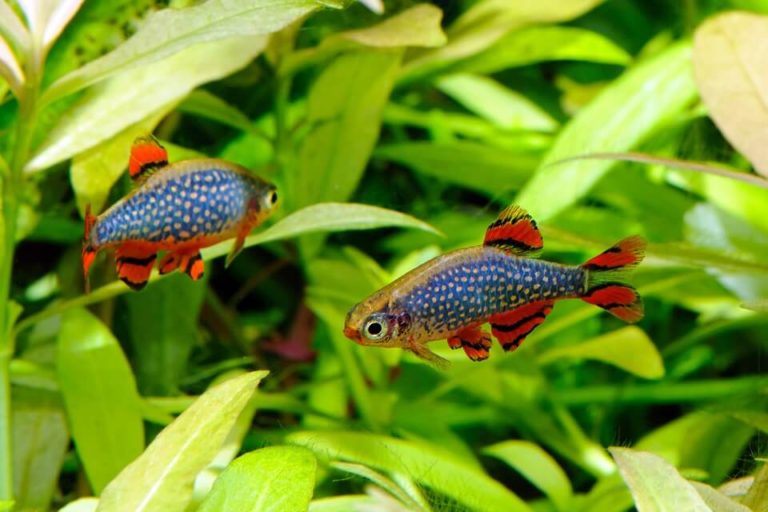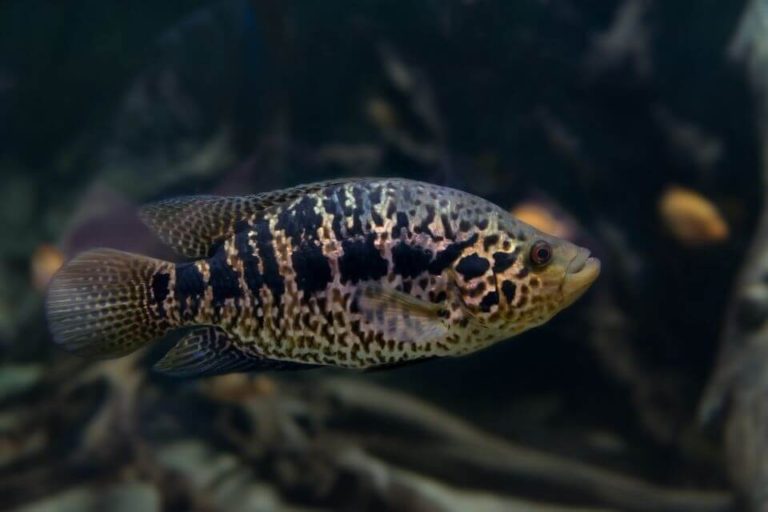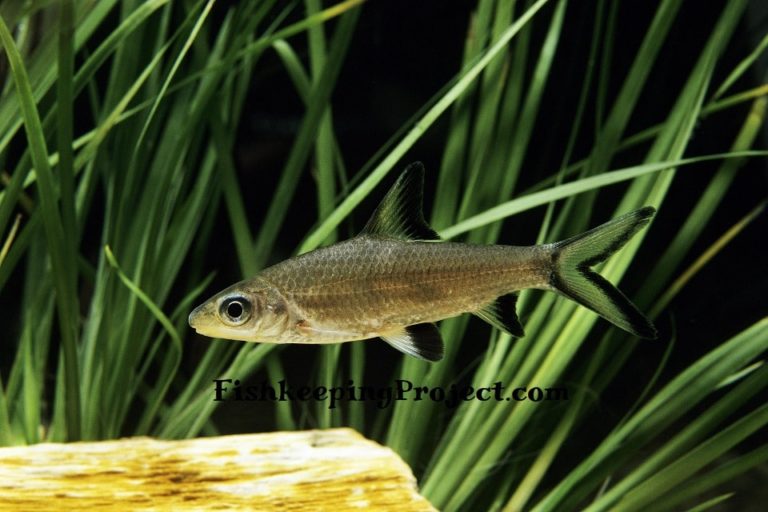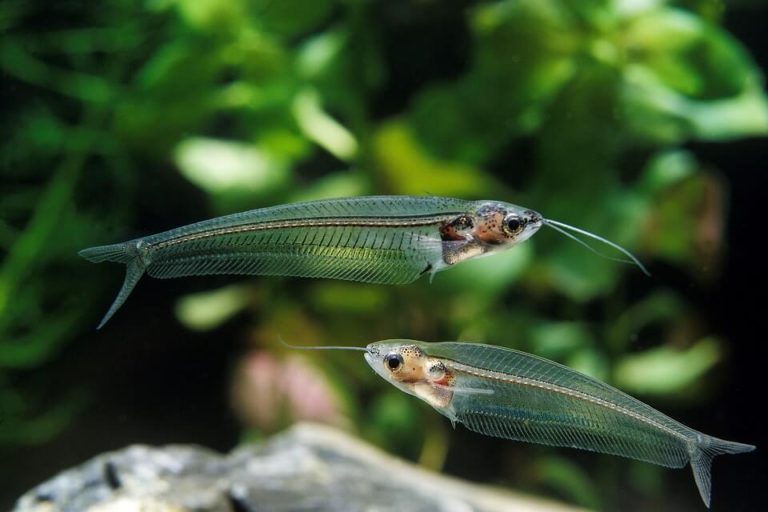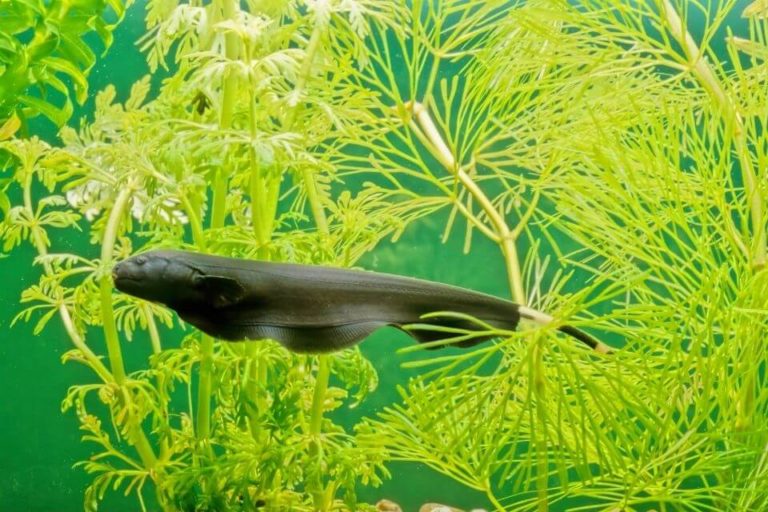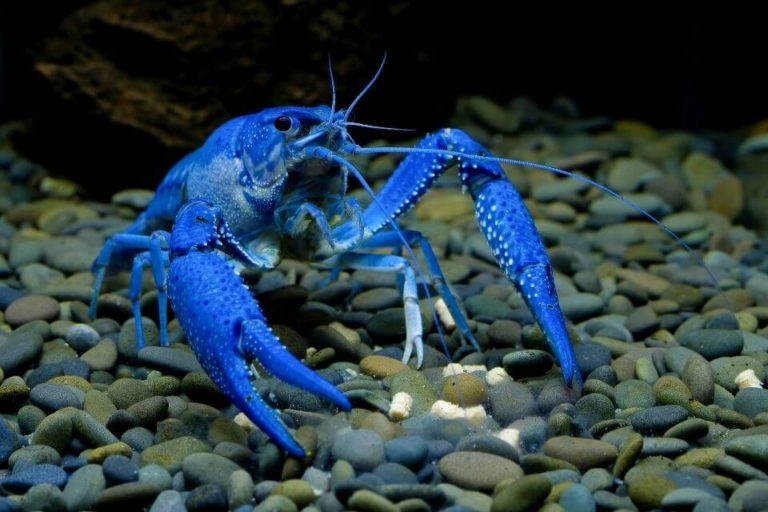Bumblebee Goby Care, Size, Lifespan, Tank Mates and Tank Size
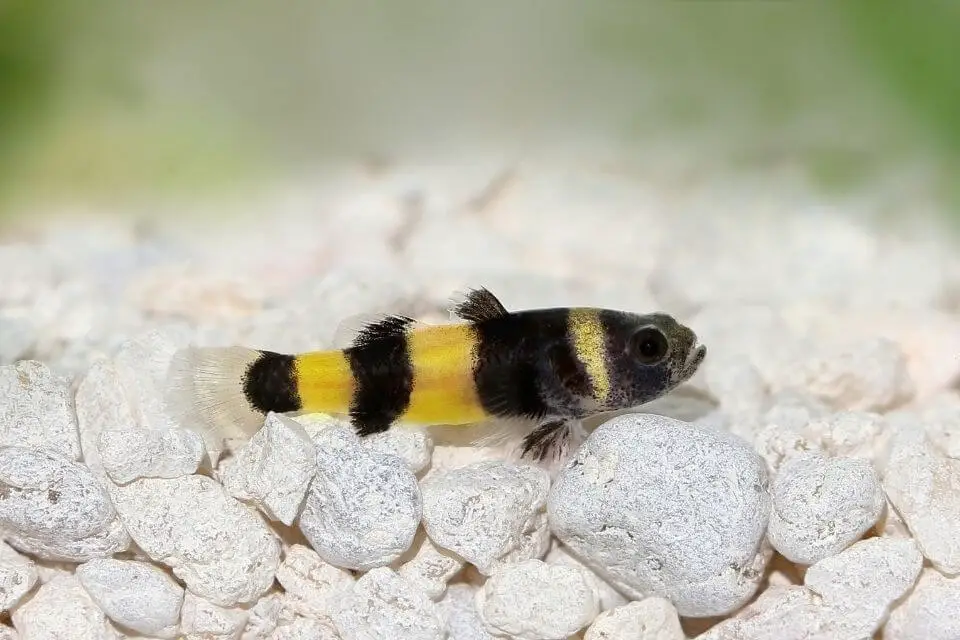
If you’re looking for a unique and fascinating fish to add to your aquarium, the Bumblebee Goby is a great choice.
These species can do well in freshwater and sometimes it thrives in Brackish water bodies such as ponds and lakes that are formulated close to the sea.
These little guys are adorable and entertaining, and they require a bit of extra care in order to thrive. In this Bumblebee Goby article, we’ll cover everything you need to know about Bumblebee Fish care.
We’ll discuss their size, lifespan, feeding requirements, and more. So if you’re interested in adding one of these little guys to your tank, keep reading!
Bumblebee Goby Overview
This fish species is a small, colorful fish that is native to the rivers and streams of Southeast Asia. These playful little fish are named for their distinctive black-and-yellow stripes, which resemble those of a bumblebee.
Bumblebee Fish are popular aquarium fish, and they make charming additions to any freshwater tank and also can be kept in slightly brackish water tanks.
These energetic fish are always on the move, and they love to explore their surroundings. They are also very social creatures, and they will often form schools with other Bumblebee Gobies.
It is a bottom-dwelling fish that typically grows to be about 1 to 1.5 inches long. It has a flattened body and a pointed head, and it is covered in tiny scales.
They are relatively peaceful fish that can be kept in groups of 5 to 6 fish with other similar-sized fish species. It is an omnivore, and it will eat just about anything, including algae, small invertebrates, and bits of plants.
When kept in captivity you may have at least 5 gallons tank and should be given plenty of hiding places, such as rocks and caves. It is a hardy fish that does not require special care, but it does need to have access to clean, oxygen-rich water.
Overall, the Bumblebee Fish makes an ideal addition to any freshwater aquarium or slightly Brackishwater tank.
Bumblebee Goby Size
The Bumblebee Goby is a small fish that typically grows to be around 1 to 1.5 inches in length. However, some specimens have been known to grow up to 2 inches in length.
Bumblebee Goby Lifespan
In the wild, the Bumblebee Goby typically has a lifespan of 2 to 3 years. However, when kept in captivity and provided with proper care, they can live for up to 4 years.
For a long lifespan, you must provide your Bumblebee Goby with a clean and well-maintained tank. Bumblebee Goby lifespan will depend on the food they are given, the water quality, and their living conditions.
Appearance And Colors
As their name suggests, these playful little fish are named for their distinctive black-and-yellow stripes, which resemble those of a bumblebee.
The Bumblebee Goby has a flattened body and a pointed head, and it is covered in tiny scales. As mentioned they will grow up to 1 to 1.5 inches in length, with some specimens reaching up to 2 inches.
Femail Bumblebee Goby tend to be a bit larger than males and also have a more rounded belly. Females will also have a vertical black stripe that runs along their bodies.
Male Bumblebee fish has brighter yellow bodies than their female counterparts. The first dorsal fin is tall and spiny, while the second is shorter and softer.
Both fins are black with transparent edges. Their coloration can vary depending on where they are found in the wild.
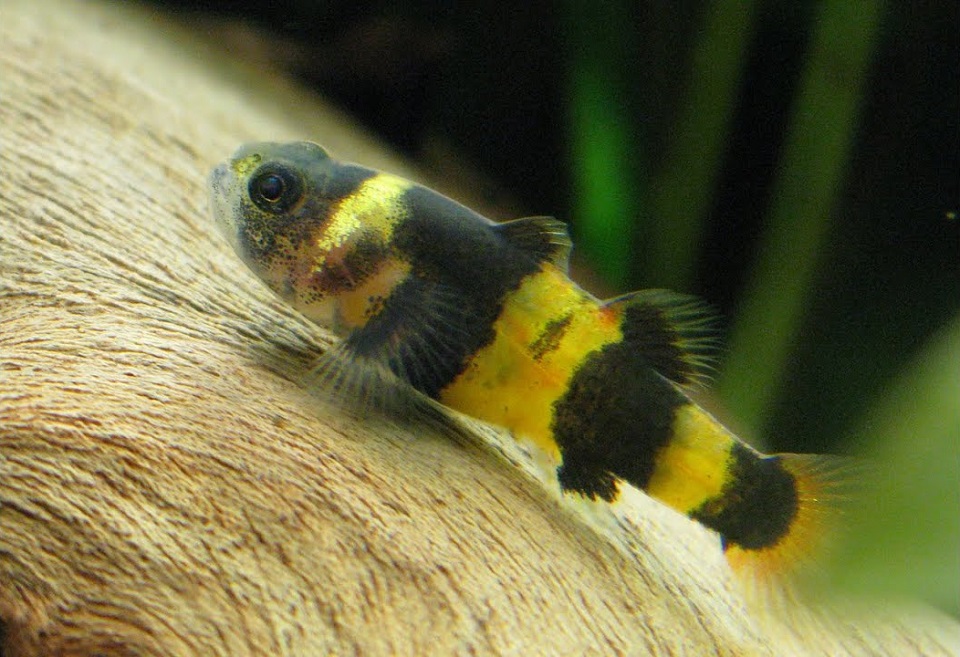
However, most Bumblebee Gobies have yellow bodies with black stripes, but some are closer to orange-colored bodies with the strips. The number of stripes can also vary, but most Bumblebee Gobies have between 5 and 7 stripes.
Some specimens may also have a white patch on their belly.
Behavior and Temperament of Bumblebee Goby
The Bumblebee Goby is a social creature that will often form schools with other Bumblebee Gobies. They are also very active fish, and they love to explore their surroundings.
They are peaceful fish that love to be in groups of 5 or 6 of the same species. The Bumblebee Goby is an omnivore, and it will eat just about anything, including algae, small invertebrates, and bits of plants.
It is a bottom-feeding fish and spends most of its time in the mid-level of the tank and plant surroundings.
These fish species like to explore the living space and should provide plenty of hiding places, such as rocks and caves to feel comfortable.
Also, they do well with same-size tank mates which allows you to keep them in a community tank.
Bumblebee Goby Care
The Bumblebee Goby is a hardy fish that does not require special care, but it does need to have access to clean, oxygen-rich water.
They are relatively easy to care for and make an ideal addition to any freshwater aquarium or slightly brackish water tank.
When kept in captivity, you may have at least 5 gallons tank and should be given plenty of hiding places, such as rocks and caves. If you stick with the following, your Bumblebee Goby will live a long and healthy life.
Bumblebee Goby Tank Size
The Bumblebee Goby is a small fish that typically grows to be around 1 to 1.5 inches in length. For this reason, a 5 gallons tank is a minimum size you should consider for your Bumblebee Goby.
When keeping with a community tank it is better to choose 10 gallons tank.
Bumblebee Goby Tank Setup
This fish species are a small, peaceful fish that originates from brackish waters in Southeast Asia. They are hardy little fish that can adapt to a wide range of water conditions, making them a great choice for beginner aquarists.
When setting up a tank for Bumblebee Fish, it is important to include plenty of hiding places and open stretches of sand or gravel for them to bury themselves in.
We would recommend the soft sandy substrate for the Bumblebee Goby tank. You can also add some plants and driftwood to provide them with hiding places and help oxygenate the water.
However, be sure to avoid any plants that have sharp edges as they can injure the Bumblebee Goby’s delicate fins.
They are active diggers and will often rearrange their tank to suit their needs, so it is important to choose substrates and decorations that can withstand their excavations.
Bumblebee gobies do best in tanks with moderate lighting and a good quality filtration system.
They are not particularly fussy eaters but will appreciate a varied diet of living, frozen, and pellets. Overall, the bumblebee goby is an easy-to-care-for fish that makes a great addition to any peaceful community aquarium.
Water Parameters And Testing
The Bumblebee Goby is a hardy fish that can adapt to a wide range of water conditions. However, they prefer slightly brackish water with a pH level of 7.5 to 8.5 and a temperature between 72 to 78 degrees Fahrenheit (22 to 25°C).
It is important to test your water regularly to ensure that it is within the ideal range for the Bumblebee Fish. We recommend testing your water at least once a week to ensure that it is clean and within the correct parameters.
If you notice any changes in your water, such as a sudden drop in pH or an increase in ammonia levels, it is important to take action immediately to correct the problem.
Bumblebee Gobies are sensitive to changes in water quality and even small fluctuations can cause them stress, which can lead to illness or death.
- Water Temperature: 72° – 78° F (22° – 25° C)
- Water Acidity Ranges: 7.0 – 8.5 pH
- Water Hardness: 6 -20 dKH
Suitable Aquarium Plants
Some suitable aquarium plants for the Bumblebee Goby Tank are Java Fern, Anubias, and Hornwort. These plants will provide them with hiding places and help oxygenate the water.
However, be sure to avoid any plants that have sharp edges as they can injure the Bumblebee Goby’s delicate fins.
Common Diseases And Prevention
The Bumblebee Goby is a hardy fish species that are relatively resistant to disease. However, like all fish, they can fall victim to a variety of illnesses if they are not properly cared for.
Some of the most common diseases that affect Bumblebee Gobies include bacterial infections, parasites, and fungal infections. Fortunately, these diseases can be easily prevented with proper care and treatment.
To prevent bacterial infections, it is important to maintain clean water conditions in your tank. This means performing regular water changes and using a high-quality filter.
You should also avoid overfeeding your fish, as uneaten food can rot and release harmful bacteria into the water.
If you notice any signs of illness in your fish, such as lethargy or loss of appetite, be sure to take them out from the tank into a separate tank and isolate them to stop spreading.
You might treat them with over-the-counter medications once you identified the diseases.
Parasites are another common problem for Bumblebee Gobies. These tiny creatures can attach themselves to your fish and feed on their blood or skin.
Common symptoms of parasite infections include scratching, redness, and excessive mucus production. To prevent parasites, it is important to quarantine new fish before adding them to your tank.
You should also regularly inspect your fish for signs of parasites and immediately remove any that you find. If you think your fish may be infected with parasites, team them with parasite treatment medication.
It is not that hard to find some medication as you might buy them over the counter.
Fungal infections are also fairly common in Bumblebee Gobies. These infections are usually caused by dirty water conditions and can cause your fish to develop white patches on their skin or fins.
To prevent fungal infections, maintain clean water conditions in your tank and treat any sick fish immediately. If you notice any signs of a fungal infection in your fish, separate them into a different tank for treatment right away.
By following these simple tips, you can help keep your Bumblebee Gobies healthy and free from disease.
Bumblebee Goby Food And Feeding Schedule
The Bumblebee Fish is not a fussy eater and will accept a variety of foods. In the wild, they typically feed on small crustaceans, worms, and insect larvae.
We recommend feeding your Bumblebee Gobies 2 to 3 times per day, using only as much food as they can eat in one sitting. This will help keep the water clean and prevent overfeeding, which can lead to health problems.
Some of the best foods for Bumblebee Gobies include brine shrimp, bloodworms, daphnia, and krill. You can also give them freeze-dried foods, such as tubifex worms and shrimp.
Be sure to offer a variety of foods to ensure that your fish are getting all the nutrients they need to stay healthy.
When it comes to feeding Bumblebee Gobies, it is important to remember that they are bottom-feeders. This means that they prefer to eat food that is close to the substrate.
To make it easier for them to find and eat their food, you can use a sinking pellet or flake food. You can also place the food directly on the bottom of the tank using tongs or chopsticks.
Bumblebee Goby Gender Difference
The easiest way to tell the difference between a male and female Bumblebee Goby is by their coloration.
Male Bumblebee Gobies are typically more colorful with black strips on their yellow color body, while females are usually light-colored with darker stripes. Another way to tell the difference is by looking at their fins.
Males usually have longer and more pointed fins than females. Female Bumblebee Goby has a much fat tummy when they are ready to breed.
Bumblebee Goby Breeding
Breeding Bumblebee Goby is not very difficult once you know what the breeding tank requirements are. The breeding tank should be at least 10 gallons, with a sandy bottom and plenty of live plants.
A small cave or similar hiding place should also be provided. The water should be clean and well-oxygenated, with a pH of 7.0 to 8.0 and a temperature of 72 to 78 degrees Fahrenheit.
To induce breeding, the male and female Bumblebee Gobies should be introduced to the breeding tank. Once breeding has begun, the eggs will be deposited in the cave or hiding place.
The eggs will hatch in approximately one week, and the fry will become free-swimming after another week. Depending on the size of the specimen and the health, the female Bumblebee Goby can lay anywhere from 150 to 200 eggs.
Once the fries are free-swimming, they can be fed baby brine shrimp or other suitable commercially available foods.
It is important to remove the male fish from the breeding tank after spawning has occurred. If left in the tank, the male Bumblebee Goby will eat the eggs or fish fries.
The fry can be difficult to raise, so it is best to leave them in the care of a professional breeder if possible.
Bumblebee Goby Tank Mates
The Bumblebee Goby is a peaceful fish that does well with other peaceful species. Some good tank mates for the Bumblebee Goby include the Neon Tetra and Platy.
It is important to avoid keeping the Bumblebee Goby with larger or more aggressive fish, as they may bully or eat them. When choosing tank mates for the Bumblebee Goby, be sure to select fish that have similar water requirements.
Bumblebee Goby Origin And Distribution
The Bumblebee Goby is native to Southeast Asia, specifically Thailand, Malaysia, and Indonesia. They can be found in slow-moving waters, such as creeks, rivers, and ponds.
The Bumblebee Goby prefers brackish water that is rich in plant life.
Because of its attractive appearance, it has gotten attention in the aquarium fishkeeping hobby and has been introduced to other parts of the world, including the United States.
Frequently Asked Questions
We have covered everything about the Bumblebee fish, but still, there are a few questions left unanswered. Let’s try to answer some of the most frequently asked questions about this beautiful creature.
Do Bumblebee Gobies Need a Partner?
No, Bumblebee Gobies do not need a partner to survive. They are perfectly capable of living alone and are often seen as solitary fish. However, they may become more active and display better coloration when kept in pairs or small groups.
Do Bumblebee Gobies Sleep?
Yes, like all other animals, Bumblebee Gobies do sleep. But since they are nocturnal animals, they sleep during the day and are more active at night.
How Long Do Bumblebee Gobies Live?
The average lifespan of a Bumblebee Goby is 2 to 3 years, although some fish have been known to live up to 5 years with proper care.
Do Bumblebee Gobies Need a Heater?
Yes, Bumblebee Gobies do need a heater to maintain a consistent water temperature if you are in cold weather countries. The ideal temperature range for these fish is 72 to 78 degrees Fahrenheit.
Are Bumble Bee Gobies Aggressive?
No, Bumblebee Gobies are not aggressive. They are peaceful fish that do well with other peaceful species. It is important to avoid keeping the Bumblebee Goby with larger or more aggressive fish, as they may bully or eat them.
Do Bumblebee Gobies Eat Algae?
Yes, Bumblebee Gobies do eat algae. In fact, they are known to help keep aquariums clean by eating algae off of the glass and decorations.
Do Bumblebee Gobies Eat Plants?
No, Bumblebee Gobies do not eat plants. In fact, they prefer tanks that are heavily planted, as this provides them with a place to hide and feel secure.
Do Bumblebee Gobies Jump Out of the Tank?
Yes, they are known to jump out of the tank if they are not properly secured. Be sure to put a tight-fitting lid on your aquarium to prevent them from escaping.
How Many Bumblebee Gobies Should Be Kept Together?
Bumblebee Gobies can be kept in small groups of about 5 to 6 fish. They are peaceful fish that do well with other peaceful species.
It is important to avoid keeping the Bumblebee Goby with larger or more aggressive fish, as they may bully or eat them.
Can I Keep Bumblebee Goby With Shrimp?
Yes, Bumblebee Gobies can be kept with shrimp without any issue as long as they are the same size and has similar aquarium requirements.
In fact, they are known to help keep aquariums clean by eating algae off of the glass and decorations.
Can Bumble Bee Goby Live In Freshwater?
There are different species that have a similar appearance and know as Bumblebee Goby. Some species are captured from brackish water regions and bred for aquarium purposes.
These species required brackish water conditions while other species from more freshwater regions do well in freshwater tanks.
Do Bumble Bee Gobies Need a Filter?
Yes, all aquariums need a filter to keep the water clean and healthy for the fish. But since Bumblebee Gobies species come from brackish water regions, they prefer a filter that provides them with moderate to high flow rates.
Where To Buy Bumblebee Goby?
You can find Bumblebee Gobies for sale at your local fish store or online retailers. When buying online, be sure to purchase from a reputable dealer to ensure you are getting healthy fish.
We recommend finding local breeders that specialize in breeding Gobies to get the best chance of success.
Conclusion
Bumblebee Gobies make beautiful, interesting aquarium pets that are fun to care for. Because of their tiny nature, they do require some special care to ensure they thrive.
These fish are best kept in small groups and prefer heavily planted tanks with plenty of hiding places. They are not aggressive and do well with other peaceful species.
Be sure to provide them with a diet of live foods and keep the water clean and well-filtered. With proper care, Bumblebee Gobies can be a joy to keep and will thrive in your aquarium for years to come.


